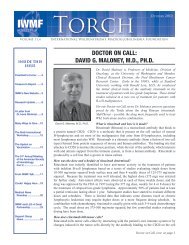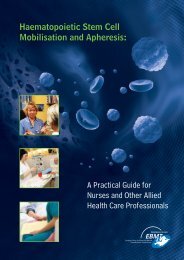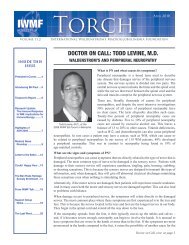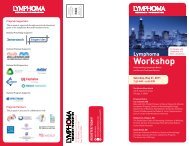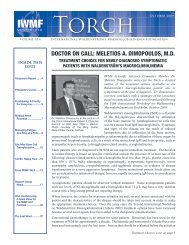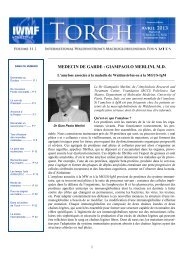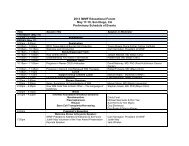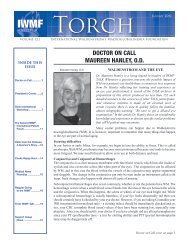Fall 2007 - International Waldenstrom's Macroglobulinemia ...
Fall 2007 - International Waldenstrom's Macroglobulinemia ...
Fall 2007 - International Waldenstrom's Macroglobulinemia ...
You also want an ePaper? Increase the reach of your titles
YUMPU automatically turns print PDFs into web optimized ePapers that Google loves.
Research Clinical Highlights, cont from page 6<br />
leukemia (AML), or transformation of WM to diffuse<br />
large B-cell lymphoma (DLBCL) with the use of<br />
nucleoside analogs, particularly fludarabine, was<br />
felt to need more data and review before a consensus<br />
statement could be made.<br />
• It is too early to recommend rituximab maintenance<br />
as long-term data are not yet available.<br />
• Age is an important factor for deciding which initial<br />
monotherapy to use (age 65 is the unofficial cut-off<br />
point); however, the measurable Performance Status<br />
of the patient is very important (a “young” 70 year<br />
old as opposed to a very sick 45 year old).<br />
• Special attention and caution are needed when<br />
using lenalidomide (Revlimid) in WM because of a<br />
possible rapid onset anemia (this is not seen in MM<br />
or CLL).<br />
• Autologous bone marrow transplants are<br />
increasingly viewed as valuable therapeutic options<br />
for the appropriate patient as the data on survival and<br />
duration of remissions are superior to many other<br />
conventional treatments.<br />
• Allogenic transplants should only be considered<br />
when absolutely necessary and in the context of a<br />
clinical trial. See the above comments on RIC or<br />
mini-allo transplants, which may be appropriate in<br />
exceptional cases.<br />
ORAL AND POSTER PRESENTATIONS<br />
Genetics, Pathophysiology and Staging System<br />
Many new and exciting discoveries are being made in the<br />
biology of WM. To date, however, problems still arise in the<br />
accurate differentiation between WM and other similar non-<br />
Hodgkins B-cell immunoglobulin (Ig) secreting lymphomas.<br />
Of particular interest is the family tree of the WM cell and<br />
determining the cell of origin along the B cell developmental<br />
path that gives rise to the WM tumor cell. Most current<br />
research has centered on the WM cell’s inability to “switch”<br />
from the initial production of IgM to the production IgG or<br />
IgA (see the IWMF publication “Introduction to Immunology<br />
in WM”). From the study of this “class switch” phenomenon<br />
(from IgM to IgG and IgA), which is arrested at the IgM<br />
level in WM (neoplastic arrest), and from the study of the<br />
immunoglobulin gene rearrangements, mutations, and class<br />
switch recombination, scientists are gaining insight into<br />
the dissimilarities between WM and IgM-MGUS. (MGUS<br />
refers to “monoclonal gammopathy of undetermined<br />
significance,” which is specified as IgM-MGUS in cases<br />
where the monoclonal protein is IgM.) This could suggest<br />
a distinct differentiation process between WM and IgM-<br />
MGUS. Furthermore, these studies will enable scientists to<br />
identify the differences and similarities between WM and<br />
other B-cell lymphoproliferative disorders, and this, in turn,<br />
can help to explain how the WM tumor cell is produced in<br />
the B-cell differentiation process.<br />
Dr. Linda Pilarski, a research scientist at the University<br />
of Alberta Cross Cancer Institute and a recipient of a large<br />
IWMF research grant, has focused her research on hyaluronan<br />
synthase 1 (HAS1). This large sugar molecule is important<br />
in cell motility, signaling, and mitosis (cell division). Dr.<br />
Pilarski’s laboratory has identified three different gene variants<br />
of HAS1, two of which are the result of partial retention of<br />
a particular segment of DNA in the gene (an intron) that<br />
is found only in patients with WM or multiple myeloma.<br />
“Intronic splicing” is seen only in cancer cells and is not<br />
found in the cells of healthy individuals. The identification<br />
of these gene variants holds promise of the development of a<br />
DNA lab test permitting not only individual risk assessment<br />
strategies for early detection and monitoring of malignancy<br />
before, during and after therapy, but also assessment of<br />
response and prediction of relapse. Furthermore, the pattern<br />
of tumor-specific DNA mutations may provide a common<br />
marker, or ID tag, for all such patients. It may also be possible<br />
to use DNA lab testing to monitor IgM-MGUS for the early<br />
stages of emerging malignancy, response to treatment, and<br />
identification of the monoclonal gammopathies that have the<br />
greatest risk of transformation to WM.<br />
Dr. Rafael Fonseca, a clinical researcher from the Mayo<br />
Clinic in Scottsdale, Arizona, and an IWMF research<br />
grant recipient, has also focused on the genetics of WM.<br />
His prolific gene expression profile studies have recently<br />
suggested that WM shares more similarities with chronic<br />
lymphocytic leukemia (CLL) than multiple myeloma (MM).<br />
Dr. Pilarski, however, contests this observation because her<br />
lab research suggests that WM is closer to MM, not CLL. Dr.<br />
Fonseca argues that, while clinically similar, the cytogenetics<br />
and genomics underlying MM and WM are quite different.<br />
The genetics of WM appears to be much simpler than those<br />
of MM, with fewer abnormalities (the 6q deletion is the<br />
most frequent abnormality in WM, observed in 16% of<br />
WM patients). Newer laboratory tools, such as array-based<br />
comparative genomic hybridization and gene expression<br />
profile, enable researchers to realize high-resolution whole<br />
genome screenings for abnormalities and to gain insight into<br />
the consequences of genomic alterations noted in WM. As is<br />
the hope of many WM patients, future therapeutic decisions<br />
may be based solely on practical clinical tools such as<br />
genomic studies.<br />
Dr. E. Morra of Italy evaluated the existing diagnostic<br />
criteria used to separate IgM-MGUS from SWM (smoldering<br />
or asymptomatic WM). Until recently, a reliable distinction<br />
of asymptomatic populations with different risks of<br />
transformation into active disease was not available. The 2 nd<br />
Research Clinical Highlights, cont on page 8<br />
PAGE 7



